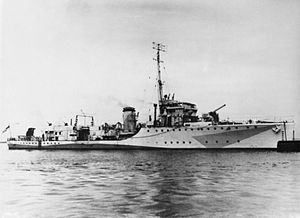| Kingfisher-class sloop | |
|---|---|
 HMS Shearwater | |
| Class overview | |
| Operators: |
|
| Built: | 1934–1939 |
| In commission: | 1935–1950 |
| Completed: | 9 |
| Lost: | 2 |
| General characteristics | |
| Type: | Sloop-of-war |
| Displacement: |
Kingfisher group; 510 long tons (518 t) standard 680 long tons (691 t) full load Kittiwake group; 530 long tons (539 t) standard 700 long tons (711 t) full load Shearwater group; 580 long tons (589 t) standard 750 long tons (762 t) full load |
| Length: |
234 ft (71 m) p/p 243 ft 3 in (74.14 m) o/a |
| Beam: | 26 ft 6 in (8.08 m) |
| Draught: |
Kingfisher group; 6 ft (1.8 m) Kittiwake group; 6 ft 3 in (1.91 m) Shearwater group; 6 ft 6 in (1.98 m) |
| Propulsion: |
2 × Admiralty 3-drum water-tube boilers Parsons geared steam turbines 3,600 shp (2,685 kW) 2 shafts 160 tons oil |
| Speed: | 20 knots (37 km/h; 23 mph) |
| Complement: | 60 |
| Armament: |
As designed |
The Kingfisher class was a class of nine patrol sloops of the British Royal Navy built in three groups of three each during the 1930s, that saw service during World War II.
Design[]
The Kingfisher class was an attempt to build a small patrol vessel under 600 tons, such vessels being outwith the clauses of the London Naval Treaty of 1930. It was intended that it would escort coastal shipping in wartime.
The design had a number of shortcomings, however. Firstly, it was simply designed to too high a standard; constructed to full naval warship specifications and powered by geared steam turbine engines, it was not suitable for mass production. Secondly, it was simply too small, short on range, and the hull-form, based on a scaled-down destroyer, was not suitable for open ocean work, where escorts were found to be dearly lacking in numbers during wartime. Thirdly, armed originally with only a single 4-inch gun forwards and depth charges aft, they were limited in their ability to defend themselves, never mind their charges.
Modifications[]
The woeful lack of defensive armament was addressed early in the war by adding a multiple Vickers machine gun on the quarterdeck in the Kingfisher and Kittiwake groups, as per the Shearwaters. As they became available, two single 20 mm Oerlikon guns were added, on single pedestal mounts on the deckhouse aft, with the useless machine gun being replaced later with a further pair of such weapons. Centimetric Radar Type 271 was added on the roof of the bridge as it became available, this was a target indication set capable of picking up the conning tower or even the periscope or schnorkel of a submarine. Radar Type 286 air warning was added at the masthead. The ships that had the Mark V gun on the open mounting HA Mark III had a shield added to give the gun crews a measure of protection on the exposed fo'c'sle.
Ships[]
Kingfisher group[]
- Kingfisher (L70) — built by Fairfield Shipbuilding and Engineering Company, Govan. Ordered 15 December 1933, keel laid down 1 June 1934, launched 14 February 1935, and completed 18 June 1935. Sold for scrapping 1947.
- Mallard (L42) — built by Alexander Stephen and Sons, Linthouse. Ordered 21 March 1935, keel laid down 12 June 1935, launched 26 March 1936, and completed 15 July 1936. Sold for scrapping 1947.
- Puffin (L52) — also built by Alexander Stephen and Sons, Linthouse. Ordered 21 March 1935, keel laid down 12 June 1935, launched 5 May 1936, and completed 26 August 1936. Rammed and damaged by German midget submarine in North Sea 26 March 1945 and written off as constructive total loss, sold for scrapping 1947.
Kittiwake group[]
- Kittiwake (L30) — built by John I. Thornycroft and Company, Woolston. Ordered on 21 January 1936, keel laid down 7 April 1936, launched 30 November 1936, and completed 29 April 1937. Sold into mercantile service 1946 as Tuch Shing.
- Sheldrake (L06) — also built by John I. Thornycroft and Company, Woolston. Ordered on 21 January 1936, keel laid down 21 April 1936, launched 28 January 1937, and completed 1 July 1937. Sold into mercantile service 1946 as Tuch Loon.
- Widgeon (L62) — built by Yarrow and Company, Scotstoun. Ordered on 13 January 1937, keel laid down 8 March 1937, launched 2 February 1938, and completed 16 June 1938. Sold for scrapping 1947.
Shearwater group[]
- Shearwater (L39) — also built by J. Samuel White and Company, Cowes; ordered 6 April 1938, keel laid down 15 August 1938, launched 18 April 1939, and completed 7 September 1939. Sold for scrapping 1947.
- Guillemot (L89) — built by J. Samuel White and Company, Cowes; ordered 6 April 1938, keel laid down 22 August 1938, launched 6 July 1939, and completed 28 October 1939. Sold for scrapping November 1950.
- Pintail (L21) — also built by J. Samuel White and Company, Cowes; ordered 6 April 1938, keel laid down 22 August 1938, launched 18 August 1939, and completed 28 November 1939. Mined in Humber estuary 10 June 1941.
Bibliography[]
- British and Empire Warships of the Second World War, H Trevor Lenton, Greenhill Books, ISBN 1-85367-277-7
- British Destroyers and Frigates; the Second World War and After, Norman Friedman, Chatham Publishing, ISBN 1-86176-137-6.
- Conway's All the World's Fighting Ships, 1922-1946, Ed. Robert Gardiner, Naval Institute Press, ISBN 0-87021-913-8
External links[]
| Wikimedia Commons has media related to Kingfisher class sloop. |
| ||||||||||||||||||||||||||||||||||||||||||||||||||
The original article can be found at Kingfisher-class sloop and the edit history here.